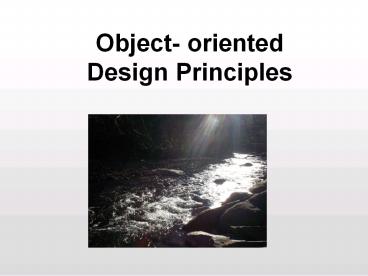Object- oriented Design Principles - PowerPoint PPT Presentation
1 / 26
Title: Object- oriented Design Principles
1
Object- oriented Design Principles
2
The pyramid of OO
Abstract/ Philosophical
Practical
3
Object-orientation is good!
4
Object-orientation is good?
5
Object-orientation is good (?)
- Why are we learning about object-orientation in
the first place? - Other paradigms for programming exist, for
instance functional programming and logic
programming - However, OO is currently the dominating paradigm
for programming more or less an industry
standard
6
Object-orientation is good!
- Object-orientation has proven to be a friutful
way of connecting real life and software
development - However, there are certain rules to obey when
playing the OO-game - At the top, we rely on a few Object-Oriented
concepts
7
Object-oriented concepts
- Abstraction
- Encapsulation
- Polymorphism
- Inheritance
- (Composition)
8
Abstraction
- The idea that we focus only on the essence of a
concept - Inessential details are abstracted away
- Abstraction works at multiple levels
- Can be a challenge to find the appropriate level
of abstraction - Abstractions are manifested through interfaces,
which define behaviors
9
Encapsulation
- The idea not to expose details about how
behaviors are achieved - Concepts are considered black boxes
- This enables us to change how behaviors are
achieved, without affecting the user of a
particular concept
10
Polymorphism
- The idea that concrete instances of a behavior
can take many forms - All animals can eat but do so in very different
ways - Eating is polymorphic behavior it can take many
forms, but has the same essence - Allows us to focus on the essence of the
behavoir, neglecting actual behaviors
11
Inheritance
- The idea that concepts can inherit behaviors from
other, more general concepts - Allows us to reuse behaviors that have previously
been defined - We can easily define hierarchies of related
concepts, only needing to add genuinely new
behaviors
12
Composition
- The idea that new concepts can be com-posed by
combining existing concepts - A supplement/alternative to inheritance
- A different approach to reuse
- Composition helps us realise has-a relations
between concepts, inheritance is used for is-a
relations
13
Fine, but
- The OO-concepts are nice, but not particularly
operational - We need something more concrete
- The OO-principles provide more specific guidelines
14
The Object-oriented principles
- 1. Encapsulate the aspects of your application
that vary - 2. Favor composition over inheritance
- 3. Program to an interface, not an implementation
- 4. Strive for loose couplings between objects
that interact - 5. Make classes open for extension, closed for
modification - 6. Depend on abstractions, not concrete classes
- 7. Only talk to your closest friends
- 8. Dont call us, well call you
- 9. A class should only have one reason to change
15
OO principles
- Where do these principles come from?
- Not from proofs or theory
- Condensed best practices from real life
- Principles are to some extent overlapping
16
OO principles
- Encapsulate the aspects of your applica-tion
that vary - Promotes reusability
- When designing classes for a system of concepts,
put the varying elements into separate classes - Can be realised both through inheritance and
composition, often using interfaces
17
OO principles
- Favor composition over inheritance
- Turns out that composition often but not always
enables us to design more flexible systems
(couplings are weaker) - Systems can also be more dynamic we can change
configurations during run-time - We shall see examples later
18
OO principles
- Program to an interface, not an imple-mentation
- An essential idea if we know the interface, we
do not need to know any details about a specific
implementation (weak coupling) - Allows us the change the implementation without
affecting the user - This is more or less encapsulation
19
OO principles
- Strive for loose couplings between objects that
interact - We like loose couplings ?
- Loose couplings promotes modularity and reuse of
classes - We usually achieve this by relying on inter-faces
rather than specific implementations - Yet another facet of the same jewel
20
OO principles
- Make classes open for extension, closed for
modification - Very important principle!
- Once we have a well-documented, well-tested
class, we should not change it! - If we need more functionality, achieve it through
extension, using inheritance and/or composition - Keep classes as pure as possible
21
OO principles
- Depend on abstractions, not concrete classes
- Variation over Program to an interface, not an
implementation
22
OO principles
- Only talk to your closest friends
- Hmm, what does that mean?
- A typical application architecture divides
classes into a number of layers - Classes in one layer should only know classes in
the next layer (loose couplings) - Avoid reliance on the specific composition of a
class
23
OO principles
- What is best, and why?
- double temp station.getThermometer().getTempera
ture() - double temp station.getStationTemperature()
- We should not rely on specifics about how a
Station is implemented - Only one . in a line of code
24
OO principles
- Dont call us, well call you
- The Hollywood Agent principle
- A more advanced principle instead of
imple-menting an algorithm using a lot of calls
to generic classes, implement a generic
algo-rithm with plugins for specialised
behavior - Also known as Inversion of Control
- Encapsulate what varies
25
OO principles
- A class should only have one reason to change
- Classes should have as few responsibilities as
possible - Closed for modification, open for extension
- Again, low coupling is desired
26
Beyond principles
- We can use these OO principles directly when
developing software - Next step is Design Patterns, which describe
designs for solving common problems, relying on
the OO principles - We have already seen some patterns (GRASP)































